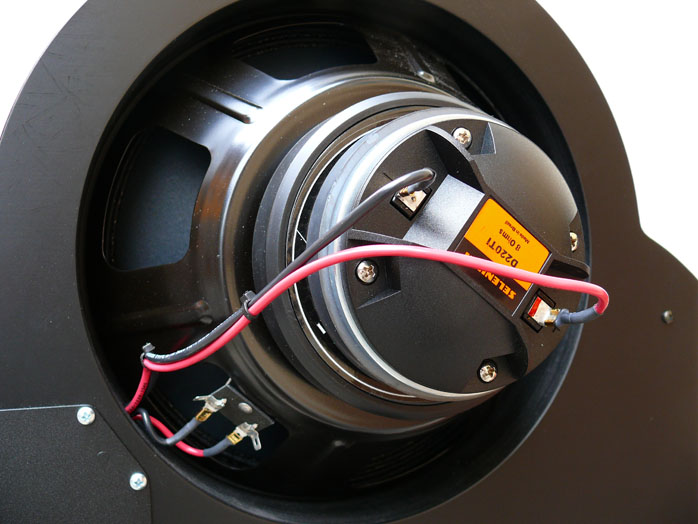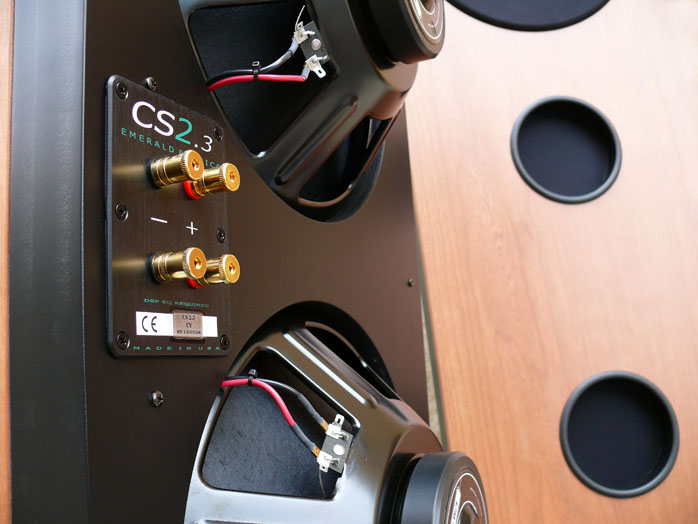This review page is supported in part by the sponsors whose ad banners are displayed below |
 |
 |
Swap that driver. While our men openly admit that the pro drivers in their Emerald Physics CS2.3 speaker are far from exotic—though they get the intended job done fine—they do have a seriously upscale transducer. It's an expensive 12-inch coaxial compression unit. Clayton first investigated it for a new Emerald center channel. That's because it can cover 80Hz to 20,000Hz to be ideal for the compact form factor a center channel demands. But this wonder driver was superior to what Emerald Physics still had in its floorstanders then.
|
 |
The tweeter screws into the Eminence 12BX, then attaches to the prepped slip-on leads |
Obviously that driver also had to benefit their big speakers. The steep price for the part sadly reserved it for the top CS1.3 with dual 18-inch woofers or the smaller models would had to undergo a significant price hike. For a friendlier approach in stages, Liederman instigated a minor redesign of the CS2.3. It now allows a customer to retrofit the monster dual-concentric at any time. The simple passive crossover different for standard and exotic coaxial has become a hot-swappable affair.
|
 |
The crossover for the standard dual-concentric. All leads remove via slip-ons.
|
|
|
Weighted amplitude. Open-baffle bass always falls prey to the so-called figure 8 cancellation. It's a pattern that sets up in the omni-directional bands between front-firing positive and rear-firing negative phase. Wavelength vs. baffle width dictates where it kicks in. By loading his woofer fronts but not their backs into short port lookalikes on the front baffle, Clayton broadens effective baffle width and also claims to gain 4dB of frontal output above 40Hz. This minimizes equalization boost and bass amp power demands.
|
 |
The biwire posts sit between the two Eminence Alpha 15A woofers |
Insult to injury. Let's take quick stock of today's proposition. Pro drivers. Pro wave guides. Pro processors. Pro software. Intense signal manipulation. Clearly this recipe is all about results. It's not about hifi-approved means getting there. The deeply conditioned in the ways of conventional hifi—or financially seriously invested—won't be early adopters if ever. Nor will the average valve amp lovers. Their cherished machines' nonlinearities so carefully matched to nonlinear speakers and ancillaries suddenly encounter speakers which measure astonishingly flat. Deliberate colorations no longer have a place to hide.
The Emerald Physics/Spatial path seems distinctly prophetic. This is very likely how things will be done eventually. Currently it goes well over the heads of generic audiophiles who distrust anything related to professional mastering equipment and computers.
|
|
|
Emerald's boss is unfazed. "I've been selling audio for over 30 years. I never had the type of universal owner satisfaction as I had with Emerald Physics from practically day one. As soon as people hear them, it's game over. With Spatial, we're now going places that weren't even conceivable before." As one of the most successful US online audio retailers, Liederman has built up a trusted customer base into which he has sold these open-baffle speakers sight unseen. His Underwood Hifi enterprise means access to many electronics options from which he can bundle complete package deals depending on the client's means and needs.
|
 |
On that subject, Walter suggested to deliver a pre-loaded Mac Mini. That would be accompanied by a TC StudioKonnekt eight-channel DAC of which four channels would bi-amp his Emerald Physic CS2.3; a ModWright KWA100 tweeter-midrange amp (as Dan Wright's office shows, he runs Emerald Physics' older CS2); a Wyred4Sound 500wpc ICEpower bass amp; and a pair of CS2.3s with all the necessary signal cabling. |
|
|
I'd also get the remote walk-thru and calibration session for the Spatial software. Usual audio reviews of course tackle one component at a time. By design, this one would have to replace one complete system with another. The entire appeal of the Spatial/Emerald proposition was the promise—guarantee on their part—that relatively modest electronics and software-charged room-corrected speakers would kick major butt on exotic designer hifi (which in theory made perfect and inescapable sense to me). The only way to confirm this was pitting my customary system (1TB iMac with WAV/AIFF files into Burson Audio HA160D or Weiss DAC2 via Firewire or USB into the Esoteric C-03 preamp into the FirstWatt J2 or F5 amplifier into the Acoustic System Int. Tango R loudspeakers) against theirs.
|
 |
  |
 |